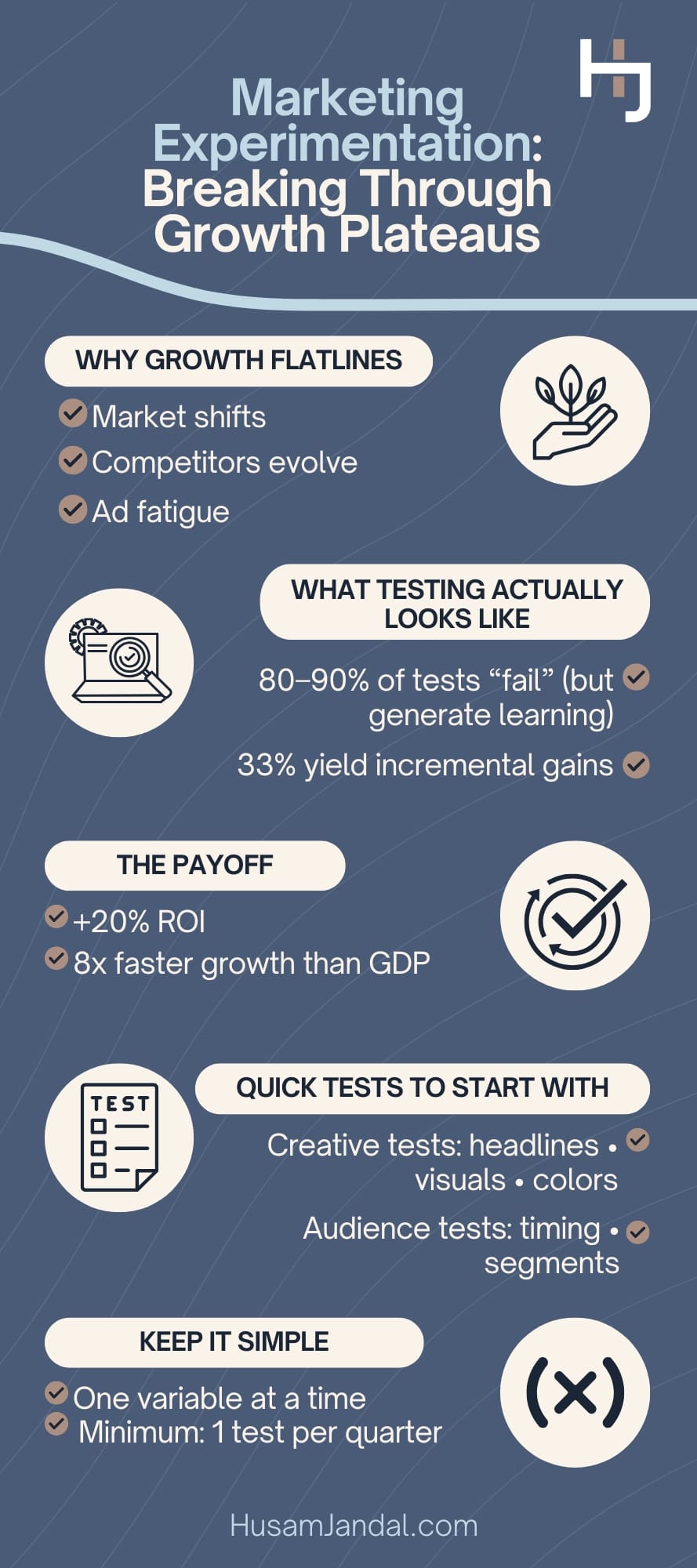 One of the most common comments I receive from business owners is that they’re doing all the things that have always worked, but that their growth has stalled or the business is shrinking. On the surface, it doesn’t make sense that this would happen because they’re using proven tactics, but in reality, that’s exactly what’s causing their growth to flatline. Once we shore up their foundations and implement the Digital Marketing Tree framework, we fold marketing experimentation into the mix. This approach ensures they begin with a sound structure and provides the forward momentum necessary to get them unstuck.
One of the most common comments I receive from business owners is that they’re doing all the things that have always worked, but that their growth has stalled or the business is shrinking. On the surface, it doesn’t make sense that this would happen because they’re using proven tactics, but in reality, that’s exactly what’s causing their growth to flatline. Once we shore up their foundations and implement the Digital Marketing Tree framework, we fold marketing experimentation into the mix. This approach ensures they begin with a sound structure and provides the forward momentum necessary to get them unstuck.
Whether you’re already coping with this common growing pain or are just starting out and trying to avoid it, this approach can work for you, too. Give me a few minutes, and I’ll walk you through why experimentation is vital to a healthy, mature marketing strategy, and how to start leveraging it without spreading your resources too thin.
Growth Stalls When Habit Takes Over
If you’re already experiencing stalled business growth and you’ve been using the same tactics that have consistently delivered results, you’re probably wary of changing things up. So, before we get into how to change things up, let’s take a look at what’s actually happening that causes growth to flatline.
The Market Never Stands Still
Marketing environments evolve constantly. If you aren’t changing along with these shifts, your tactics will slowly lose power.
- Algorithm Adjustments: It’s estimated that Google Search receives thousands of updates annually, per Search Engine Journal. This is only one platform. All search engines, social networks, and advertising platforms are refined on an ongoing basis. Even small updates can change which formats perform best or which audiences see your content.
- Ad Fatigue: As people grow accustomed to the same message or creative, they begin to tune it out. Engagement naturally declines, and campaigns lose their impact.
- Competitive Adaptation: New competitors emerge. Many businesses will keep testing and refining their approaches, too. If your business isn’t improving its marketing and finding new ways to stand out, it will be left behind.
Businesses Double Down on What Feels Safe
There are few things scarier or more destabilizing for business owners than declining leads and sales. When you feel this shift, your natural instinct tells you to create stability. When that happens, most gravitate to what they know and trust. In fact, you might even double or triple your efforts and budgets, pouring even more into tactics that have stopped working.
- Old Success Becomes the Benchmark: Past results become the definition of what “works,” even when the environment has already changed.
- Routine Replaces Awareness: Focus stays on execution instead of observation, and small shifts in buyer behavior either go unseen or unaddressed.
- Familiarity Crowds Out Curiosity: Proven tactics start feeling like the only safe ones, leaving little room for exploration.
Marketing Experimentation is the Antidote
Ideally, you’d introduce experimentation into your marketing strategy when things are on an upswing. When it’s added through this lens, you gain the sense that you’re making incremental improvements rather than taking a risk. However, a lot of small business owners, especially those who have worked hard over many years to earn their growth and don’t have a mature marketing strategy, don’t have this advantage. Pivoting at a time of instability can feel downright uncomfortable. But rest assured, marketing experimentation is a proven tactic in and of itself, even if you haven’t personally worked with it.
Testing Creates Momentum

One of the most important benefits of marketing experimentation is that it gets you unstuck. It helps put you in the mindset where creativity and innovation are the norm. These are skills that can be strengthened like muscles, so the more you use them, the better you become at testing new ideas efficiently and the stronger your results become.
This behavior is often contagious, so as you do it more, your team will likely follow suit. Their diverse perspectives will add even more fresh ideas to the mix and will ultimately challenge you to continuously innovate and springboard new ideas off theirs.
Even “Failed” Experiments Give You New Data
It’s important to have realistic expectations about your testing. It’s estimated that 80 to 90 percent of tests “fail,” Harvard Business Review (HBR) reports. What this essentially means is that the new version doesn’t outperform what you’re already doing. It either shows no change or performs worse. These are not true failures in the way that most people use the word; it’s information.
In marketing, a failed experiment still has value. You learn what doesn’t work. In learning what doesn’t work, you move closer to finding out what does. For instance, you might learn that your audience does not respond to a sale or discount-driven messaging, but does respond to things that focus on value and trust. Once you know this, you can refine your messaging further.
Tests Can Improve Results
While it’s true that “success” rates are low for most, industry leaders identify incremental improvements in up to 33 percent of tests, according to Eppo. Young companies may perform even better. For instance, a study of startups revealed that performance improves 30 to 100 percent with A/B testing, per Harvard Business School (HBS).
Improved Results Lead to Higher ROI and a Stronger Business
Naturally, the goal of marketing experimentation is to strengthen your overall business, and it delivers there, too. For instance, it has helped global companies boost return on investment (ROI) by 20 percent or more, according to Bain & Company. It does this, not only by helping you move to more successful approaches, but by allowing you to eliminate wasted spend.
Not surprisingly, this also means businesses that create a healthy culture around experimentation grow at least eight times faster than the global gross domestic product (GDP), Kameleoon reports.
Set Yourself Up for Success with the Right Testing Tools
Once you decide to make experimentation an ongoing process, the next step is ensuring you have the tools to support it. Broadly speaking, these fit into three categories: analytics, management, and execution tools. In many cases, individual tools fit into all categories, so your tech stack does not need to be massive. Moreover, you may already have access to many of these tools without adding additional subscriptions to your budget.
Analytics Tools
Most of the execution tools include reporting tools that can help you tell which variants are most effective. However, you should still have a broad analytics tool that can give you a clearer overview of the different channels and how things work together. One of the most popular solutions here is Google Analytics, which is free for businesses to use.
Marketing Project Management Software
A marketing project management tool is also essential. It gives you a central place to plan experiments, record results, and see where each test stands. While many businesses start with spreadsheets, these lack the ability to guide execution. As you move from executing tasks out of habit to testing new things, processes will change. Having a system to manage each task, and often subtasks like coming back to review results, is invaluable.
Native Platform Solutions
Take time to explore what’s already available in platforms and services you already leverage. Many offer capabilities that go unused simply because they’re hidden in the settings. For instance, most email and ad platforms already include built-in A/B testing, so you can experiment with subject lines, visuals, or calls to action without additional software.
Customer Relationship Management Software
Your customer relationship management (CRM) software plays an equally important role. While you may be able to tell which variant is a winner in terms of conversions based on data from your testing tool, you won’t be able to tell if those conversions become customers, and if they are profitable and stay. Your CRM reporting can provide these insights and help you connect your marketing activities back to your business objectives, so you can tell if what you’re doing is actually strengthening your business as a whole.
Webpage Testing Tools
For webpage testing, you have a few options. You can manually create two versions of a page and split ad traffic evenly between them, or use a dedicated platform for easier management.
The manual option tends to work well if you’re working with a native platform solution that can split traffic between two links. For instance, your ad or email program can evenly divide traffic between two pages, allowing you to do an A/B test without additional software.
Additionally, this is one of the areas where exploring your additional tech stack may be helpful. For instance, many businesses start with a program like Zoho CRM. But if you’re signed up for their Zoho One program, you can access most of their other programs at no additional cost, including email marketing, project management, and PageSense, the conversion optimization and personalization platform. This is only one example. Both HubSpot and Salesforce offer similar capabilities. The important thing is that, if budget is a concern, it’s essential to begin by exploring what’s already available.
Lastly, if you don’t have access to testing tools through the platforms and services you’re already using, or you graduate beyond what they offer, there are standalone tools available. For instance, Hotjar, Optimizely, and Crazy Egg fit into this bucket.
Password Management
Finally, this is the ideal time to introduce a password manager if you haven’t done so already. When you’re marketing at scale, you’re no doubt leveraging a plethora of tools. Sharing passwords can become complicated, and many people recycle passwords between systems, all of which puts your security at risk. A good password manager, such as Bitwarden or LastPass, will help introduce good password hygiene, streamline sharing, and keep access more secure.
Start Experimenting by Running Small Tests

You don’t need to set out to reinvent the wheel here. Sometimes the smallest, most imperceptible changes can produce surprising results. For instance, Google once ran a “50 shades of blue” experiment, The Guardian reports. As the name implies, this involved testing which shade of blue worked best for ad links on Gmail. After testing, the brand had a clear winner, and running with it netted them an extra $200 million in annual revenue.
Most businesses won’t see this level of improvement through a single test because they’re not operating at the same scale, but you can still achieve impressive results, even if you have limited time and budget.
Adjust Your Messaging
Even subtle shifts in tone or focus can change how your audience interprets your message. Try simplifying your wording, emphasizing benefits instead of features, or highlighting different pain points. Each variation helps you understand what resonates most and how your brand voice connects with people today.
Change the Visuals
Visuals set the emotional tone for your content. Test alternative imagery, angles, or styles that align with your message but convey it in different ways. Sometimes, a more human photo, a cleaner layout, or a more dynamic composition can capture attention that your current creative misses.
Swap Out Colors
As the Google experiment shows, color influences perception and emotion in dramatic ways. Experiment with different accents or button colors, or adjust your background tones to draw focus where you want it most. Even a small shift in contrast can affect engagement and help clarify which visual cues guide your audience best.
Shift Your Send Time
Timing affects attention. Try delivering your emails or posting on social media at slightly different hours or on different days. You may find that a time that once performed well no longer aligns with when your audience is most responsive. This small adjustment can improve visibility without costing a cent.
Work with a Different Segment
If your results are flattening, test your assumptions about who your ideal customer is. Narrow your focus to a smaller, high-intent group or expand slightly to reach adjacent audiences. Seeing how each segment interacts with your content can reveal new opportunities or untapped demand.
Reframe Your Offer
If you typically promote the same type of incentive, try presenting it in a different way. For instance, if your standard promotion offers 25 percent off, test stating the savings in dollars instead or offering a free item of equal value. If you usually lead with a free consultation, try offering a downloadable guide or another useful resource instead. The offer itself may stay the same, but changing how it’s positioned can make it feel fresh and spark renewed interest.
Experiment with Emojis 🧪
Because emojis can evoke emotion and enhance marketing messages, many brands find they’re worth including in certain types of content. Try using them in email subject lines and social media posts. Experiment with different types to see if some perform better than others.
Turn Curiosity into a System
Once you begin experimenting, the next step is to make it part of how your business operates. A single test can spark insight, but consistent learning comes from having a system.
Define What You Expect to Happen
Start every test with a clear hypothesis. Identify what you’re changing and what you think will occur as a result. For instance, “If we shorten our email subject line, open rates will increase because the message is easier to read on mobile.” This level of clarity turns curiosity into measurable learning.
Track Results in a Central Place
As mentioned, your project management tool or spreadsheet can fill this need. You want to make it easy to plan your upcoming tests, follow through each step, and see patterns over time. Even brief notes on what succeeded and what didn’t will help you make more informed decisions later.
Share Insights with Your Team
Learning multiplies when it’s shared. Whether you run a small team or work with outside partners, discuss what each test revealed and what might come next. When experimentation becomes a shared practice, creativity improves, and everyone starts thinking more strategically about how to grow.
Keep the Cycle Going
Focus on one variable at a time when you’re testing. For instance, if you’re testing a landing page, you might change only the button color in one test. If you’re testing button color, copy, and images, it’s impossible to know which variable impacted your results.
This naturally means you’ll need to run lots of little tests before you have a clear picture of what really works. But as we covered earlier, your marketing environment is always changing, too. Because of this, you want to keep testing new ideas even if what you’re doing is already effective.
At the same time, the opportunities for marketing experimentation are unlimited, and your resources likely are not. Ideally, when one test concludes and the results are analyzed, you’ll immediately move on to the next test. However, if you are unable to maintain this level of momentum, aim for at least one test per quarter. Over time, this steady rhythm keeps your marketing adaptive, evidence-based, and aligned with how your market continues to change.
Get Help Folding Marketing Experimentation into Your Strategy
Hopefully, this guide has inspired you and given you the insights necessary to develop your own marketing experimentation strategy. Even if you only start on a small scale, every test helps. But if you’re running a more established company and experiencing declining growth, implementing all the necessary changes and waiting for results might take time your business does not have. This is where bringing in outside help becomes essential.
I’m a seasoned marketing consultant with a background in business, helping small businesses and Fortune 100 companies reach their goals for decades. Whereas most marketing agencies can come in and oversee the redesign of a website or launch campaigns, I address your digital marketing holistically. That means we don’t just look at one campaign or even one channel. We bring everything into alignment and ensure you have a strong foundation to support growth, and then amplify your lead generation through a mix of proven techniques and experimentation. This approach has been proven to turn businesses around in a matter of months. If you think it might be the solution you’re looking for, let’s chat.
Marketing Experimentation FAQs
What are some ways to leverage A/B testing in marketing?
A/B testing helps isolate what drives performance. Compare headlines, visuals, or calls to action on a single campaign, measure the difference, and apply what works more broadly. Keep tests focused on one variable at a time so outcomes are clear and insights translate directly to stronger marketing decisions.
Why is digital strategy testing important?
Testing ensures your digital strategy reflects current audience behavior instead of assumptions. Because platforms, algorithms, and buyer expectations evolve constantly, small, continuous tests keep campaigns aligned with what performs now. Over time, testing reduces wasted spend and strengthens every decision with data rather than guesswork.
How do pilot campaigns differ from mature campaigns?
Pilot campaigns are designed for learning. They test messaging, audiences, and creative elements on a small scale to confirm direction before full rollout. Mature campaigns build on proven data from those pilots, emphasizing optimization and consistency instead of discovery. Both are essential stages in a sustainable marketing cycle.
Why is testing important in digital marketing?
Testing bridges the gap between what you think works and what actually performs. It reveals how real audiences respond to your content and helps identify areas for improvement. Without testing, digital marketing decisions rely on assumptions, making it harder to adapt to ongoing changes in the market.
How do I break out of outdated marketing tactics?
Start by questioning long-held assumptions. Identify which strategies you continue using because they’re familiar rather than effective. Then run small tests with new ideas or formats. Seeing clear evidence that a fresh approach works builds confidence and helps retire tactics that no longer deliver meaningful results.
What are examples of successful A/B testing in strategy?
Global brands routinely use A/B testing to guide decisions. Google’s “50 shades of blue” test revealed which link color improved engagement, generating hundreds of millions in additional revenue. Similar tests comparing subject lines, pricing formats, or ad creative often produce measurable lifts in conversion and audience response.
How can I create a culture of experimentation?
Lead by example. Treat testing as a normal part of decision-making rather than a special project. Recognize learnings as wins, even when results underperform. When leadership values curiosity and rewards insight, teams feel safe sharing ideas and begin to view experimentation as a path to progress.
What should I test first in my marketing plan?
Focus on high-impact elements that are easy to change, such as headlines, visuals, or timing. These simple adjustments produce clear, measurable results without requiring major investment. Early success with small, visible tests builds support for deeper experimentation and helps establish a rhythm of continuous improvement.
How do I connect testing to actual ROI?
Track metrics that link directly to business outcomes, such as qualified leads, conversions, or customer lifetime value. Compare these results to the baseline before testing. When improved performance aligns with measurable financial gains, it becomes easier to prove that experimentation drives revenue, not just engagement.
Why do some companies resist experimentation?
Resistance often comes from comfort and risk aversion. Teams may fear losing stability or exposing weaknesses in current strategies. Showing real examples of small, low-cost tests that deliver insight helps shift the mindset from fear to curiosity. Data makes experimentation feel safer and more practical.
How often should I run marketing tests?
Testing should be continuous but manageable. Aim for a steady rhythm; perhaps one or two small tests per campaign or quarter, so learning remains active without overwhelming your team. The goal is sustained discovery: always gaining fresh insight to guide smarter, evidence-based marketing decisions.
What frameworks help organize testing?
Simple structures like the “hypothesis, test, learn” cycle or the Build-Measure-Learn framework keep experimentation consistent. Document what you’re testing, why, and what success looks like. Recording each result ensures insights compound over time, turning isolated tests into a structured system of ongoing learning.
How do I stop relying on guesswork in marketing?
Replace assumptions with small, measurable experiments. Define what you expect to happen, test it, and compare results. As you repeat the process, decisions rely less on instinct and more on verified evidence. This steady feedback loop builds confidence and eliminates uncertainty in your marketing choices.
How can I use testing in data-driven decision-making?
Testing produces the data that powers better decisions. Each experiment reveals how real audiences behave, clarifying where to invest time and budget. When you treat every campaign as a source of learning, your strategy evolves from static plans to adaptive, evidence-based growth.





































































